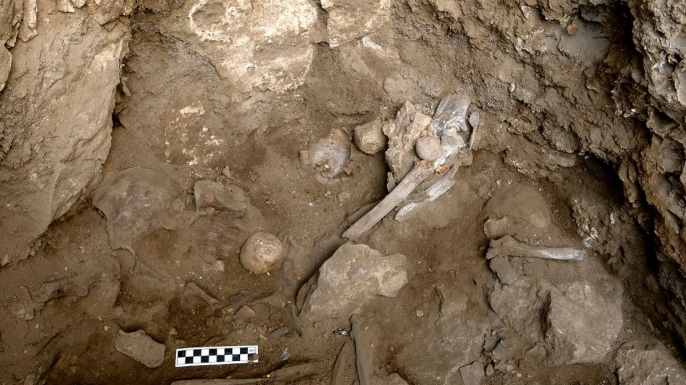During an excavation in 2005, a prehistoric woman was found within a cave popularly known as Hilazon Tachtit. Located in northern Israel, the woman was found within a shallow grave inside of the cave. It has taken the team of archaeologists years to completely reconstruct the elaborate funeral. The woman’s funeral was so elaborate that it even included a feast of 86 tortoises. Experts believe that due to the elaborate nature of the grave site, the woman was possibly a shaman. Archaeologists also believe that this shaman lived during the Late Natufian period which was between 10,800 B.C. to 9,500 B.C.

Photo: History
This elaborate grave site is also believed to be one of the oldest prehistoric burials sites. The site also contained the remains of around 28 other individuals.
The woman’s burial was particularly interesting. She was laid on a bed of materials ranging from seashells, tortoise shells, chalk, sediment, and gazelle horns. In addition to these materials, a wide variety of animal bones were found within the cave, including a bone from a human foot. Researchers have found that the woman was close to 45 years old at the time of death, which was beyond average for this time period. Not only have they figured out her age, they’ve figured out that this woman suffered a wide variety of diseases.
This particular excavation was led by Natalie Munro and Leore Grosman. The artifacts that Munro and Grosman’s team found were in very good condition. Due to their almost perfect condition, the team of archaeologists were able to reconstruct the funeral. This reconstruction allowed experts to trace the shaman’s time period.
The reconstruction began by preparing the grave for the shaman’s burial, which was a six stage process. Someone would mark an oval shape on the floor of the cave using a drill of some sort. The walls and floors of the cave would then be covered with limestone and mud. After this was complete, the grave pit would then be lined with tortoise shells, gazelle horns, limestone, and any other materials. Moving on to the fourth stage, attendee’s would place the body into the grave, insert tortoise shells on both sides of her head, pelvis, and along the walls of the grave. Afterwards they would then place more shells and bones around the woman.
Archaeologists believe that the attendees would then pile their garbage from their feast on top of and around the woman. The amount of tortoise shells indicate that many of these were placed within the grave after the large feast. Experts also believe that the attendees would consume around 55 pounds of meat at one of the burial feast. During the final stage of the burial, the attendees would then move a large block in the shape of a triangle towards the top of the grave.
Due to the amount of bones within the grave, this led experts to believe that she might have been a shaman. During this time period, many believed that shamans could commune with animal spirits. Archaeologists also believe that the woman was apart of the Natufian people. The Natufian people are believed to be the first modern humans that were living 15,000 years ago, due to them forming permanent settlements. They were known to hunt and gather, but eventually began to grow their own food.
This particular shamans grave has also led experts to believe that funerary practices were becoming extremely important within their culture. This practice gives new insight into the Natufian culture, showing us that they were a very complex society. You can read a detailed analysis of Munro and Grosman’s findings in the journal called Current Anthropology.

